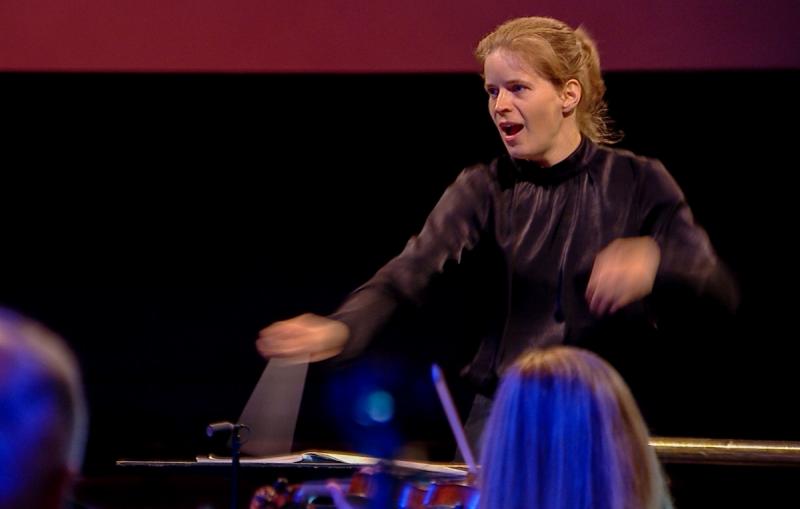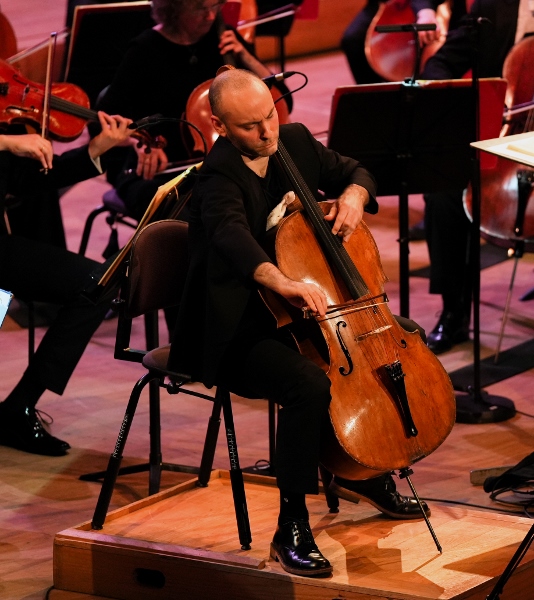Koranyi, Hallé, Berglund, Bridgewater Hall, Manchester review - beauty and joy | reviews, news & interviews
Koranyi, Hallé, Berglund, Bridgewater Hall, Manchester review - beauty and joy
Koranyi, Hallé, Berglund, Bridgewater Hall, Manchester review - beauty and joy
Cello soloist teamed with a former-cellist conductor for outstanding performance

It’s catching on … for the second consecutive night I heard an orchestra begin by playing, to a standing audience, the Ukrainian national anthem.
The outstanding performance of the evening came from a Swede, cellist Jakob Koranyi, in Dvořák’s Cello Concerto, wisely positioned as the opening event. With the brass well and truly off the leash in the big tutti passages, it made for a dynamically varied and rewarding performance, the soloist able to shrink his role to the merest murmur at times such as the close of the slow movement and towards the end of the finale. A feature of the concerto is the succession of duetting themes for cello with the orchestral wind soloists, and in that respect the Hallé has enviably gifted people in its ranks.
 Koranyi (pictured left) has a beautiful and rich tone (lots of D string soulfulness) ideally suited for the cantabile melodies that fill this work, and Berglund – herself a professional cellist in an earlier existence – made sure that his sound was audible against the full string numbers of the Hallé whenever it needed to be. Tabita Berglund kept the rhythms lively in the opening movement and lilting in the second, and didn’t forget that the orchestral celli have important moments of their own. The return to big orchestral gestures at the close of the whole piece can sometimes appear ham-fisted and jarring: here it did not, but simply affirmative and joyful.
Koranyi (pictured left) has a beautiful and rich tone (lots of D string soulfulness) ideally suited for the cantabile melodies that fill this work, and Berglund – herself a professional cellist in an earlier existence – made sure that his sound was audible against the full string numbers of the Hallé whenever it needed to be. Tabita Berglund kept the rhythms lively in the opening movement and lilting in the second, and didn’t forget that the orchestral celli have important moments of their own. The return to big orchestral gestures at the close of the whole piece can sometimes appear ham-fisted and jarring: here it did not, but simply affirmative and joyful.
There was a UK premiere to follow: This Too, by the Norwegian saxophonist, jazz band leader and composer known as Mette Henriette (real name Martedatter Rølvåg). It’s a very short piece – about five minutes – and something of an exercise in getting small sounds from a big orchestra, beginning with near-niente violas and harp and adding whispered percussion and breathy noises from the brass. It was written “during the height of the global pandemic” (funny how people talk about this as if it’s over) with the intention, in the composer’s words, of being something real and sincere for that time ... there was a sense of cold and loneliness, I thought, but I’m not sure it went very far beyond that.
Bartók’s Concerto for Orchestra made a real contrast. Written in wartime 1943 by a Hungarian who had fled his homeland (and there are signs of his longing for it in the music, as Tabita Berglund pointed out), it’s a wonderful display piece for musicians on their mettle and was directed with imagination and conviction.
Moments of passion flared up wonderfully in the first movement, with energetic brass playing, and lively articulation from the duetting wind players in the second. The central Elegia was the high point of the whole thing, as intended, with the strings (led by Hannah Perowne) on fine form, and the finale had both thoughtfulness and thrilling helter-skelter as it drove to its conclusion. Tabita Berglund’s conducting style – alert, encouraging and inspiring – seems to bring out exceptional music-making.
rating
Share this article
The future of Arts Journalism
You can stop theartsdesk.com closing!
We urgently need financing to survive. Our fundraising drive has thus far raised £49,000 but we need to reach £100,000 or we will be forced to close. Please contribute here: https://gofund.me/c3f6033d
And if you can forward this information to anyone who might assist, we’d be grateful.

Subscribe to theartsdesk.com
Thank you for continuing to read our work on theartsdesk.com. For unlimited access to every article in its entirety, including our archive of more than 15,000 pieces, we're asking for £5 per month or £40 per year. We feel it's a very good deal, and hope you do too.
To take a subscription now simply click here.
And if you're looking for that extra gift for a friend or family member, why not treat them to a theartsdesk.com gift subscription?
more Classical music
 Goldscheider, Brother Tree Sound, Kings Place review - music of hope from a young composer
Unusual combination of horn, strings and electronics makes for some intriguing listening
Goldscheider, Brother Tree Sound, Kings Place review - music of hope from a young composer
Unusual combination of horn, strings and electronics makes for some intriguing listening
 theartsdesk Q&A: composer Donghoon Shin on his new concerto for pianist Seong-Jin Cho
Classical music makes its debut at London's K-Music Festival
theartsdesk Q&A: composer Donghoon Shin on his new concerto for pianist Seong-Jin Cho
Classical music makes its debut at London's K-Music Festival
 Helleur-Simcock, Hallé, Wong, Bridgewater Hall, Manchester review - moving lyricism in Elgar’s concerto
Season opener brings lyrical beauty, crisp confidence and a proper Romantic wallow
Helleur-Simcock, Hallé, Wong, Bridgewater Hall, Manchester review - moving lyricism in Elgar’s concerto
Season opener brings lyrical beauty, crisp confidence and a proper Romantic wallow
 Kohout, Spence, Braun, Manchester Camerata, Huth, RNCM, Manchester review - joy, insight, imagination and unanimity
Celebration of the past with stars of the future at the Royal Northern College
Kohout, Spence, Braun, Manchester Camerata, Huth, RNCM, Manchester review - joy, insight, imagination and unanimity
Celebration of the past with stars of the future at the Royal Northern College
 Jansen, LSO, Pappano, Barbican review - profound and bracing emotional workouts
Great soloist, conductor and orchestra take Britten and Shostakovich to the edge
Jansen, LSO, Pappano, Barbican review - profound and bracing emotional workouts
Great soloist, conductor and orchestra take Britten and Shostakovich to the edge
 Jakub Hrůša and Friends in Concert, Royal Opera review - fleshcreep in two uneven halves
Bartók kept short, and a sprawling Dvořák choral ballad done as well as it could be
Jakub Hrůša and Friends in Concert, Royal Opera review - fleshcreep in two uneven halves
Bartók kept short, and a sprawling Dvořák choral ballad done as well as it could be
 Hadelich, BBC Philharmonic, Storgårds, Bridgewater Hall, Manchester review - youth, fate and pain
Prokofiev in the hands of a fine violinist has surely never sounded better
Hadelich, BBC Philharmonic, Storgårds, Bridgewater Hall, Manchester review - youth, fate and pain
Prokofiev in the hands of a fine violinist has surely never sounded better
 Monteverdi Choir, ORR, Heras-Casado, St Martin-in-the-Fields review - flames of joy and sorrow
First-rate soloists, choir and orchestra unite in a blazing Mozart Requiem
Monteverdi Choir, ORR, Heras-Casado, St Martin-in-the-Fields review - flames of joy and sorrow
First-rate soloists, choir and orchestra unite in a blazing Mozart Requiem
 Cho, LSO, Pappano, Barbican review - finely-focused stormy weather
Chameleonic Seong-Jin Cho is a match for the fine-tuning of the LSO’s Chief Conductor
Cho, LSO, Pappano, Barbican review - finely-focused stormy weather
Chameleonic Seong-Jin Cho is a match for the fine-tuning of the LSO’s Chief Conductor
 Classical CDs: Shrouds, silhouettes and superstition
Cello concertos, choral collections and a stunning tribute to a contemporary giant
Classical CDs: Shrouds, silhouettes and superstition
Cello concertos, choral collections and a stunning tribute to a contemporary giant
 Appl, Levickis, Wigmore Hall review - fun to the fore in cabaret and show songs
A relaxed evening of light-hearted fare, with the accordion offering unusual colours
Appl, Levickis, Wigmore Hall review - fun to the fore in cabaret and show songs
A relaxed evening of light-hearted fare, with the accordion offering unusual colours
 Lammermuir Festival 2025, Part 2 review - from the soaringly sublime to the zoologically ridiculous
Bigger than ever, and the quality remains astonishingly high
Lammermuir Festival 2025, Part 2 review - from the soaringly sublime to the zoologically ridiculous
Bigger than ever, and the quality remains astonishingly high

Add comment